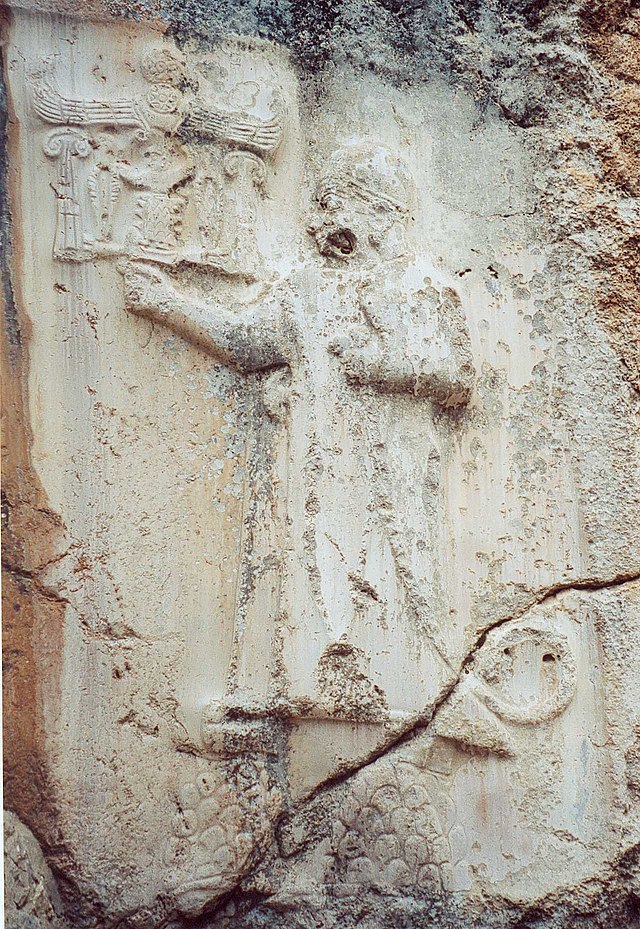Top Qs
Timeline
Chat
Perspective
List of Hittite kings
From Wikipedia, the free encyclopedia
Remove ads
The dating and sequence of Hittite kings is compiled by scholars from fragmentary records, supplemented by the finds in Ḫattuša and other administrative centers of cuneiform tablets and more than 3,500 seal impressions providing the names, titles, and sometimes ancestry of Hittite kings and officials. Given the nature of the source evidence, reconstructions vary among scholars, and the dating or even existence, relationships and sequence of some kings is disputed at several point within Hittite history. The list below indicates instances of such debates, with references.

All dates in the list below should be considered approximate. Hittite Chronology is almost completely dependent on synchronisms with other ancient Near Eastern countries.[2] Such synchronisms are few and usually open to interpretation. Muršili I is believed to have overthrown Samsu-ditāna, the last king of the Amorite dynasty of Babylon, but the dating of this event varies widely across chronological schemes based on interpretations of the records of observation of Venus during the reign of Samsu-ditāna's predecessor. These have resulted in several chronologies for Mesopotamia. In reference to the capture of Babylon by Muršili I, these are High (1651 BC), Middle (1595 BC), Low (1531 BC), and Ultra-Low (1499 BC),[3] with additional variants such as the lower Middle Chronology (1587 BC).[4] The distinction between these Mesopotamian chronological models disappears in the Late Bronze Age. Egyptian chronology is also subject to variant interpretations, resulting in three leading options, High (1304 BC), Middle (1290 BC), and Low (1279 BC), for the accession of Ramesses II, the contemporary of the Hittite kings Muwatalli II and Ḫattušili III.[5] Assuming the preferred Low Chronology for Egypt, Ramesses II fought Muwatalli II at Kadesh in 1274 BC (Year 5), concluded a peace treaty with Ḫattušili III in 1259 BC (Year 21), and married the latter's daughter Maathorneferure in 1246 BC (Year 34).[6]
On the Hittite side there are very few precise indicators. The "Apology" of Ḫattušili III indicates that his nephew and predecessor Muršili III reigned for 7 years.[7] A text of Muršili II records an omen of the sun at the beginning of the campaign season against Azzi-Ḫayaša, in Year 9 or 10 of the reign. It is often considered to have been a solar eclipse, with current scholarly opinion divided between one on 24 June 1312 BC (which was visible from central Anatolia but seemingly late in the year, apparently adopted in the chronologies of Amélie Kuhrt and Trevor Bryce) and one on 13 April 1308 BC (which was earlier in the year but marginally visible, from eastern Anatolia, apparently adopted in the chronology of Jacques Freu).[8]
The lists below use variations of the Mesopotamian Middle Chronology, the most generally accepted chronology of the Ancient Near East and the chronology that accords best with Hittite evidence.[9] The variants represented below derive from three comprehensive reconstructions of the chronological sequence of rulers, by Amélie Kuhrt (1995), Trevor Bryce (2005), and Jacques Freu (2007). All regnal dates remain approximations.
Remove ads
Old kingdom
Remove ads
Middle kingdom (often not distinguished from Old kingdom)
Remove ads
New kingdom
Remove ads
Bibliography
- Bilgin, Tayfun (2018), Official and Administration in the Hittite World, Berlin.
- Beckman, Gary (2000), "Hittite Chronology," Akkadica 119-120 (2000) 19-32.
- Bryce, Trevor (2005), The Kingdom of the Hittites, Oxford.
- Freu, Jacques, and Michel Mazoyer (2007), Les débuts du nouvel empire hittite, Paris.
- Gautschy, Rita (2017), "Remarks Concerning the Alleged Solar Eclipse of Muršili II," Altorientalische Forschungen 44 (2017) 23-29.
- Höglmayer, Felix, and Sturt W. Manning, "A Synchronized Early Middle Bronze Age Chronology for Egypt, the Levant, and Mesopotamia," Journal of Near Eastern Studies 81 (2022) 1-24.
- Huber, Peter J. (2001), "The Solar Omen of Muršili II," Journal of the American Oriental Society 121 (2001): 640-644.
- De Jong, Teije, and Victoria Foertmeyer (2010), "A New Look at the Venus Observations of Ammisaduqa," Jaarbericht Ex Oriente Lux 42 (2010) 141-157.
- Kuhrt, Amélie (1995, reprinted 2020), The Ancient Near East: c.3000–330 BC, Volume One, Routledge.
- Wilhelm, Gernot (2004), "Generation Count in Hittite Chronology," in Hermann Hunger and Regine Pruzsinszky (eds.), Mesopotamian Dark Age Revisited, Vienna: 71-79.
Remove ads
See also
- List of Neo-Hittite kings, for the rulers of the Neo-Hittite states, some of whom were direct descendants of the Hittite kings
- The rulers of Carchemish in particular presented themselves as successors of the Hittite kings and ruled in northern Syria until defeated by the Assyrians in 717 BC.
- History of the Hittites
- Tawananna, for Hittite queens
Notes
References
Wikiwand - on
Seamless Wikipedia browsing. On steroids.
Remove ads






